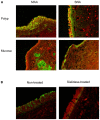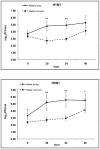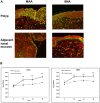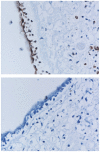Enhanced susceptibility of nasal polyp tissues to avian and human influenza viruses
- PMID: 20885984
- PMCID: PMC2945772
- DOI: 10.1371/journal.pone.0012973
Enhanced susceptibility of nasal polyp tissues to avian and human influenza viruses
Abstract
Background: Influenza viruses bind and infect respiratory epithelial cells through sialic acid on cell surface. Differential preference to sialic acid types contributes to host- and tissue-tropism of avian and seasonal influenza viruses. Although the highly pathogenic avian influenza virus H5N1 can infect and cause severe diseases in humans, it is not efficient in infecting human upper respiratory tract. This is because of the scarcity of its receptor, α2,3-linked sialic acid, in human upper airway. Expression of sialic acid can be influenced by various factors including inflammatory process. Allergic rhinitis and nasal polyp are common inflammatory conditions of nasal mucosa and may affect expression of the sialic acid and susceptibility to influenza infection.
Methodology/principal finding: To test this hypothesis, we detected α2,3- and α2,6-linked sialic acid in human nasal polyp and normal nasal mucosal tissues by lectin staining and infected explants of those tissues with avian influenza viruses H5N1 and seasonal influenza viruses. We show here that mucosal surface of nasal polyp expressed higher level of α2,3- and α2,6-linked sialic acid than normal nasal mucosa. Accordingly, both H5N1 avian influenza viruses and seasonal influenza viruses replicated more efficiently in nasal polyp tissues explants.
Conclusions/significance: Our data suggest a role of nasal inflammatory conditions in susceptibility to influenza infection, especially by avian influenza viruses, which is generally inefficient in infecting human upper airway. The increased receptor expression may contribute to increased susceptibility in some individuals. This may contribute to the gradual adaptation of the virus to human population.
Conflict of interest statement
Figures






Similar articles
-
Use of ex vivo and in vitro cultures of the human respiratory tract to study the tropism and host responses of highly pathogenic avian influenza A (H5N1) and other influenza viruses.Virus Res. 2013 Dec 5;178(1):133-45. doi: 10.1016/j.virusres.2013.03.003. Epub 2013 May 15. Virus Res. 2013. PMID: 23684848 Free PMC article. Review.
-
Tropism and Infectivity of a Seasonal A(H1N1) and a Highly Pathogenic Avian A(H5N1) Influenza Virus in Primary Differentiated Ferret Nasal Epithelial Cell Cultures.J Virol. 2019 May 1;93(10):e00080-19. doi: 10.1128/JVI.00080-19. Print 2019 May 15. J Virol. 2019. PMID: 30814288 Free PMC article.
-
The avian influenza A virus receptor SA-α2,3-Gal is expressed in the porcine nasal mucosa sustaining the pig as a mixing vessel for new influenza viruses.Virus Res. 2024 Feb;340:199304. doi: 10.1016/j.virusres.2023.199304. Epub 2024 Jan 3. Virus Res. 2024. PMID: 38142890 Free PMC article.
-
Unique immune and other responses of human nasal epithelial cells infected with H5N1 avian influenza virus compared to seasonal human influenza A and B viruses.Emerg Microbes Infect. 2025 Dec;14(1):2484330. doi: 10.1080/22221751.2025.2484330. Epub 2025 Apr 7. Emerg Microbes Infect. 2025. PMID: 40126073 Free PMC article.
-
Tissue and host tropism of influenza viruses: importance of quantitative analysis.Sci China C Life Sci. 2009 Dec;52(12):1101-10. doi: 10.1007/s11427-009-0161-x. Epub 2009 Dec 17. Sci China C Life Sci. 2009. PMID: 20016966 Review.
Cited by
-
Transcriptomics unravels molecular changes associated with cilia and COVID-19 in chronic rhinosinusitis with nasal polyps.Sci Rep. 2023 Apr 21;13(1):6592. doi: 10.1038/s41598-023-32944-3. Sci Rep. 2023. PMID: 37085563 Free PMC article.
-
Herpes simplex virus type 1 infection facilitates invasion of Staphylococcus aureus into the nasal mucosa and nasal polyp tissue.PLoS One. 2012;7(6):e39875. doi: 10.1371/journal.pone.0039875. Epub 2012 Jun 29. PLoS One. 2012. PMID: 22768151 Free PMC article.
-
The battle between influenza and the innate immune response in the human respiratory tract.Infect Chemother. 2013 Mar;45(1):11-21. doi: 10.3947/ic.2013.45.1.11. Epub 2013 Mar 29. Infect Chemother. 2013. PMID: 24265946 Free PMC article. Review.
-
Use of ex vivo and in vitro cultures of the human respiratory tract to study the tropism and host responses of highly pathogenic avian influenza A (H5N1) and other influenza viruses.Virus Res. 2013 Dec 5;178(1):133-45. doi: 10.1016/j.virusres.2013.03.003. Epub 2013 May 15. Virus Res. 2013. PMID: 23684848 Free PMC article. Review.
-
Atopic conditions other than asthma and risk of the 2009 novel H1N1 infection in children: a case-control study.Allergy Asthma Proc. 2013 Sep-Oct;34(5):459-66. doi: 10.2500/aap.2013.34.3686. Allergy Asthma Proc. 2013. PMID: 23998244 Free PMC article. Clinical Trial.
References
-
- Suzuki Y. Sialobiology of influenza: molecular mechanism of host range variation of influenza viruses. Biol Pharm Bull. 2005;28:399–408. - PubMed
-
- Rogers GN, Paulson JC. Receptor determinants of human and animal influenza virus isolates: differences in receptor specificity of the H3 hemagglutinin based on species of origin. Virology. 1983;127:361–373. - PubMed
-
- Shinya K, Ebina M, Yamada S, Ono M, Kasai N, et al. Avian flu: influenza virus receptors in the human airway. Nature. 2006;440:435–436. - PubMed
-
- Nicholls JM, Chan MC, Chan WY, Wong HK, Cheung CY, et al. Tropism of avian influenza A (H5N1) in the upper and lower respiratory tract. Nat Med. 2007;13:147–149. - PubMed
Publication types
MeSH terms
Substances
LinkOut - more resources
Full Text Sources
Medical

